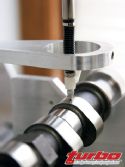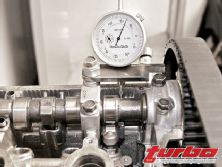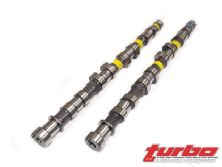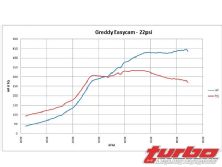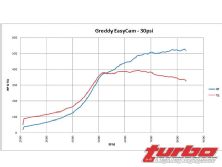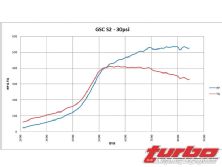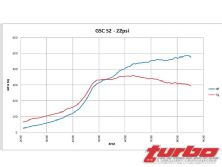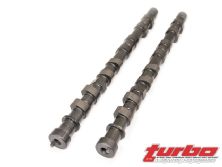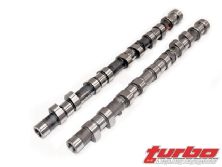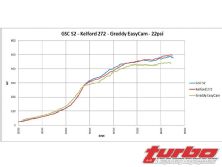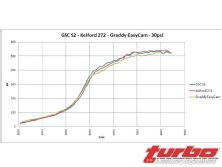In this third installment of the camshaft shootout I'll start to look at the details of cam timing and how it can affect power. The writing of these articles has really re-ignited my interest in the theory of the internal combustion engine. I've even dusted off the old college engineering books. Unfortunately my math and thermodynamics skills aren't what they used to be and it was quite a challenge to refresh even some of the basics. I spent nights pouring over books and Society of Automotive Engineers' papers about internal combustions engines and realized just how complex the subject really is. It seems simple-just get the air in the engine and then get it out, how hard can it be? If you really take a look at how many things are going on in an engine and how it's all dynamic, it really poses a puzzle that I can only barely scratch the surface of. What you'll read in this article is just a basic assumption of what I've learned from my research and testing and by no means does it apply across the board to every engine. If there's one thing I've learned about camshafts it's that it's really a game of sacrifices and complete dependence on the engine combination. Encouraging news right? So, you may ask, what are you to do to with your naturally aspirated Nissan VQ35 engine, and what cams do you choose? Although you can follow some of the same basic principles that I discuss here, it really comes down to hard science and experimentation to learn what your combination needs.
Timing Events And How They Affect Performance
Timing events are particular to the engine setup as a whole, and one generalization does not work the same for every engine. Contrary to popular belief, retarding an intake cam won't always make power at higher rpm.
Intake Valve Opening
Early intake valve opening is beneficial to both good and poor flowing intake ports. It allows more time for the intake charge to start moving into the cylinder. The exhaust port flow and exhaust-closing event will really determine how early you can open the intake valve. An earlier intake valve opening will increase the overlap period when both the intake and exhaust valves are open. With a poor flowing exhaust port an earlier intake valve opening can cause the exhaust charge to pollute the intake charge. This needs to be taken into consideration in our turbocharged application since a turbo is an exhaust restriction that reduces exhaust flow. Typically, as we near the limits of a particular turbocharger, the exhaust backpressure rises. On my test car, I fitted a pressure probe into the collector of the header and recorded the pressure through the AEM EMS. I found that at 30 psi of boost, I was seeing about 45 psi of exhaust pressure at redline. This is a good time to really explain the overlap period. Overlap period is how much time both the intake valve and exhaust valve are open. While it seems to not make sense to have both the intake and exhaust valve open at the same time, there is logic behind it. As the piston nears the top, the exhaust gas is still moving past the rapidly closing exhaust valve. This exhaust gas has energy and can actually help to pull in fresh intake charge as the intake valve starts to open. If the timing is right the exhaust gas will leave a depression, or low-pressure area, behind it, literally sucking in the fresh intake charge. You can actually have intake charge flowing into the cylinder before the piston starts moving down the bore and drawing in the intake charge. This overlap tuning effect occurs near a certain rpm window and, in our example, can be impeded by the exhaust backpressure. I was running my test car at 20 psi of boost and I was only seeing 20 psi of exhaust backpressure, as opposed to the 45psi exhaust pressure at 30 psi of boost. Since this exhaust-to-intake pressure ratio changes at different boost levels, the overlap period requirements can change, making valve timing a little tricky on turbocharged cars.
Intake Valve Closing
A good flowing intake port can take advantage of later intake valve closing. At higher rpm, where a good flowing port is still unrestricted, the later intake valve closing is allowing the charge air to fill the cylinder and build cylinder pressure. A poor flowing port that is choked at a lower rpm can benefit from earlier intake valve closing. It's important to build as much cylinder pressure as possible when closing the intake valve. If the intake port is choked and can't keep filling the cylinder, it's advantageous to close the intake valve earlier so the cylinder pressure is maintained. As you can imagine throwing a long duration camshaft that closes the intake valve late on a poor flowing engine combination will most likely hurt low to midrange power without making any peak power gains. Intake valve closing is very important and can have a dramatic impact on power production and the power curve.
Exhaust Valve Opening
A restrictive exhaust port can benefit from earlier exhaust valve opening. Opening the exhaust valve early bleeds off the pressure from the power stroke that is pushing down on the piston and producing torque, but at the same time it gives the exhaust more time to evacuate the cylinder through the exhaust port. It takes power to push the exhaust gases out the exhaust port, this is called pumping loss. The earlier exhaust valve opening on a poor flowing exhaust port can reduce this pumping loss and increase power. The trick is for the reduction in pumping loss to outweigh the power lost in the power stroke. With a good flowing exhaust port and little backpressure we can open the exhaust valve later because it's easier for the exhaust gas to get out of the cylinder (lower pumping loss). The later exhaust valve opening also keeps more cylinder pressure in the power stroke. My initial thoughts told me that since the turbocharger is a restriction on the exhaust side, a turbo car, especially with a stock turbo, can really benefit from opening the exhaust early; conducting a test on a stock turbo car changed my thinking. I installed an aggressive exhaust camshaft on a stock turbo car and it lost a lot of low-end torque, and didn't make much more peak power. I remembered that a turbocharged engine makes power a little differently than a naturally aspirated engine. The cylinder pressure that pushes down on the piston from the combustion process last longer, meaning it pushes down longer over the rotation of the crank. Imagine giving a naturally aspirated combustion stroke a quick and violent shove and the turbocharged a steady long push. This steady long push can be cut short when you start to open the exhaust valve too early. Remember that the exhaust valve starts to open well before the piston reaches the bottom of the power stroke to give the exhaust gas time to get out. Well, now we have a dilemma. If we open the exhaust valve too early we lose low rpm power but if we open it too late we lose top-end power due to pumping loss. This led me to another thought. The restriction (turbine) is after the exhaust port/valve and at lower mass flow rates (rpm), the exhaust port to turbine flow ratio. Remember that a turbocharger acts like a restriction after the exhaust port so the exhaust valve opening event requirement will be different than that of a naturally aspirated engine.
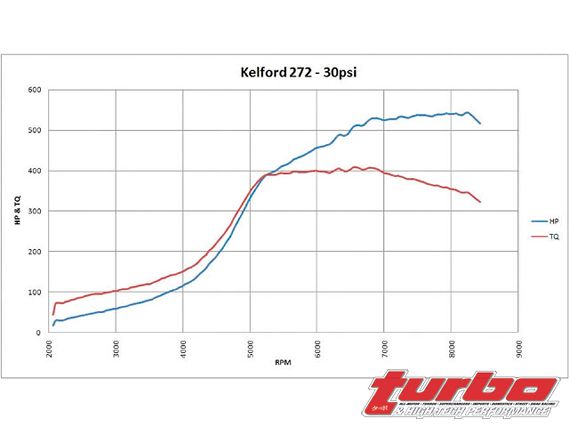 | Mitsubishi Lancer Evolution - Camshaft Shootout
| Mitsubishi Lancer Evolution - Camshaft Shootout
Exhaust Valve Closing
Exhaust valve closing is dependent on intake port flow, exhaust port flow, and intake valve opening. Poor flowing exhaust ports with a lot of backpressure need to have the exhaust valve closed earlier in relation to the intake valve open to reduce overlap. The high exhaust backpressure can pollute the intake charge if the overlap is too great. Basically an engine with poor flowing exhaust ports won't benefit from much overlap. If the exhaust port flows well and the intake flows well then it can be beneficial to close the valve later and allow for more overlap. Another scenario is a good flowing exhaust port and poor flowing intake port. This combination can benefit from more overlap because the evacuating low-pressure exhaust gas can help draw in the intake charge and increase intake port velocity. This is not the case in our turbocharged application where most likely our intake side flows better than our exhaust side.
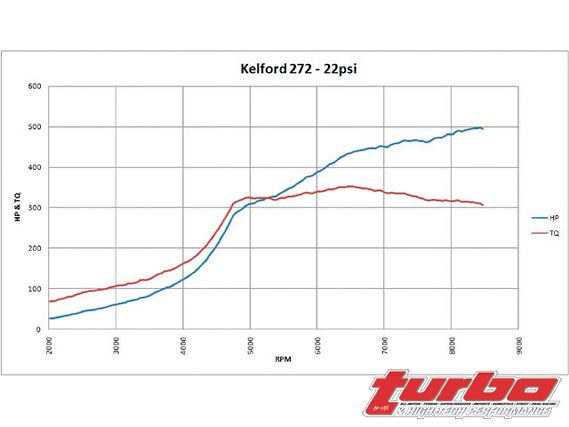 | Mitsubishi Lancer Evolution - Camshaft Shootout
| Mitsubishi Lancer Evolution - Camshaft Shootout
As testing is drawing to a conclusion, I've started to see a pattern in the cam profiles that I can correlate to dyno data along with what I've learned from my research. I can see things like lift profile and opening/closing events making a significant impact on performance. Although some cams are advertised as having the same duration, the rest of the picture (profile) and the dyno data shows a huge difference. I still have at least one camshaft to test, the TOMEI 280 solid lifter cam, that I'll compare to its hydraulic counterpart. In addition, the next and last installment will include a comprehensive camshaft summary along with some of the conclusions I've drawn about the cam designs and how they performed.



